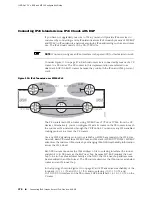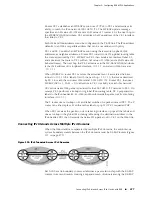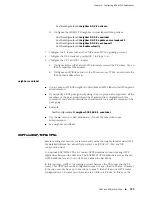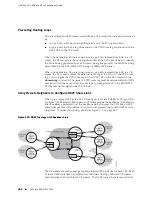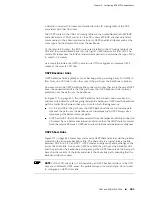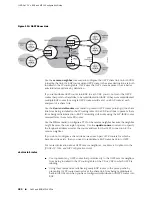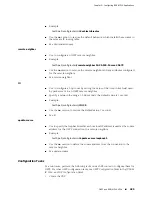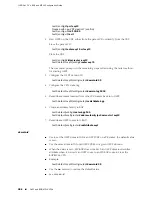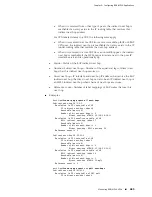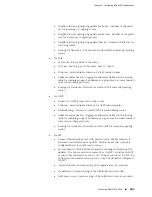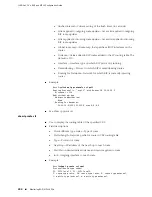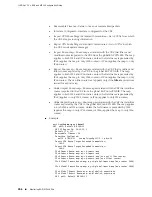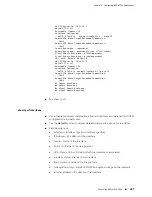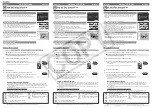
a directly connected CE router are installed into the IP routing table of the VRF
associated with that CE router.
The OSPF routes in the VRF’s IP routing table are then redistributed into MP-BGP
and advertised as VPNv4 routes to other PE routers. MP-BGP attaches extended
communities to the advertised routes to carry OSPF-specific attributes such as the
route type and the domain ID across the backbone.
At the remote PE router, the BGP routes are installed in the IP routing table of the
VRF and then redistributed back into the logical OSPF instance for that VRF. The
remote PE router uses the BGP extended communities to determine the type of LSA
to send to CE routers.
As a result the intra-area OSPF routes in one VPN site appear as interarea OSPF
routes at the remote VPN sites.
OSPF Backdoor Links
OSPF backdoor links typically serve as backup paths, providing a way for traffic to
flow from one VPN site to the other only if the path over the backbone is broken.
However, when the OSPF backdoor link connects two sites that are in the same OSPF
area, the undesired result is that the path over the OSPF backdoor link is always
preferred over the path over the backbone.
In Figure 112 on page 482, the OSPF backdoor link connects customer site 4 to
customer site 5 directly, without going through the backbone. OSPF uses the backdoor
path for traffic flow between these two sites for the following reasons:
■
At CE 4 and CE 5, the path over the OSPF backdoor link is an intra-area path,
whereas the path over the backbone is an interarea path. OSPF always uses
intra-area paths before interarea paths.
■
At PE 2 and PE 3, the OSPF routes received from the respective directly connected
CE routers have a better administrative distance than the IBGP routes received
from the remote PE router. OSPF uses routes with better administrative distances.
OSPF Sham Links
Figure 113 on page 484 shows how you can use OSPF sham links to avoid the problem
created by the intra-area backdoor link. The sham link is a logical intra-area link
between VRF B on PE 2 and PE 3. OSPF creates an adjacency and exchanges LSAs
across the sham link. As a result, OSPF sees both the path over the backdoor link
and the path over the backbone as intra-area paths. OSPF then selects the best path
based on the metrics of the links and selects the sham link path, ensuring that the
backdoor link is not used.
NOTE:
If the VPN sites are not connected by an OSPF backdoor link or if the VPN
sites are in different OSPF areas, the problem does not exist and you do not need
to configure an OSPF sham link.
OSPF and BGP/MPLS VPNs
■
483
Chapter 5: Configuring BGP-MPLS Applications
Summary of Contents for BGP
Page 6: ...vi ...
Page 8: ...viii JUNOSe 11 1 x BGP and MPLS Configuration Guide ...
Page 37: ...Part 1 Border Gateway Protocol Configuring BGP Routing on page 3 Border Gateway Protocol 1 ...
Page 38: ...2 Border Gateway Protocol JUNOSe 11 1 x BGP and MPLS Configuration Guide ...
Page 234: ...198 Monitoring BGP JUNOSe 11 1 x BGP and MPLS Configuration Guide ...
Page 236: ...200 Multiprotocol Layer Switching JUNOSe 11 1 x BGP and MPLS Configuration Guide ...
Page 542: ...506 Monitoring BGP MPLS VPNs JUNOSe 11 1 x BGP and MPLS Configuration Guide ...
Page 544: ...508 Layer 2 Services Over MPLS JUNOSe 11 1 x BGP and MPLS Configuration Guide ...
Page 610: ...574 Virtual Private LAN Service JUNOSe 11 1 x BGP and MPLS Configuration Guide ...
Page 624: ...588 VPLS References JUNOSe 11 1 x BGP and MPLS Configuration Guide ...
Page 680: ...644 Virtual Private Wire Service JUNOSe 11 1 x BGP and MPLS Configuration Guide ...
Page 724: ...688 Monitoring MPLS Forwarding Table for VPWS JUNOSe 11 1 x BGP and MPLS Configuration Guide ...
Page 725: ...Part 6 Index Index on page 691 Index 689 ...
Page 726: ...690 Index JUNOSe 11 1 x BGP and MPLS Configuration Guide ...








